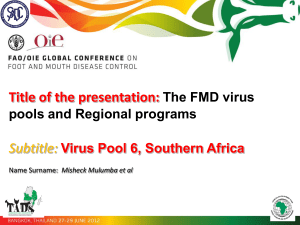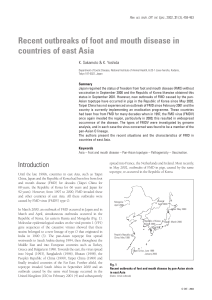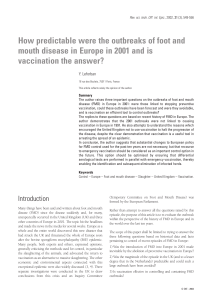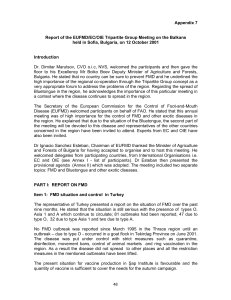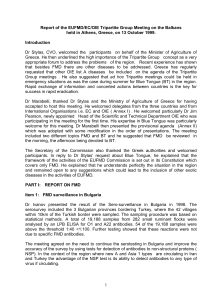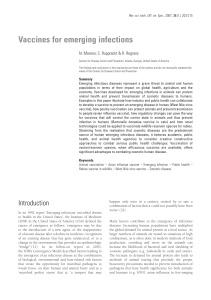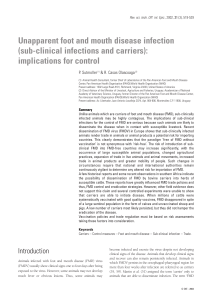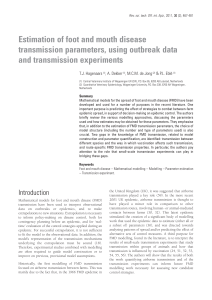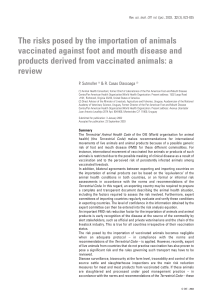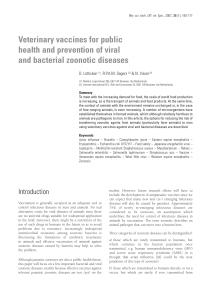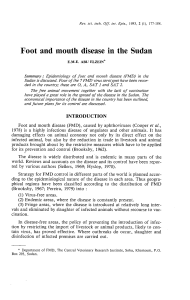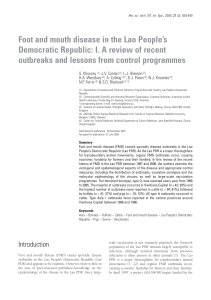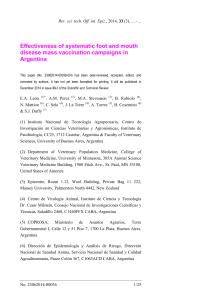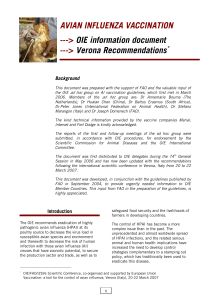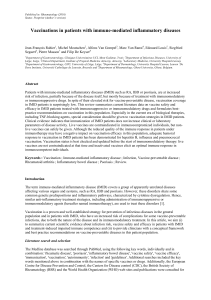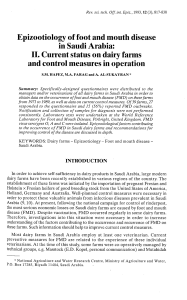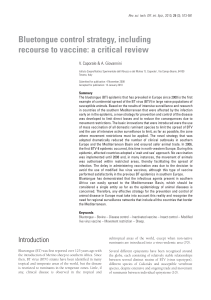D6947.PDF
publicité
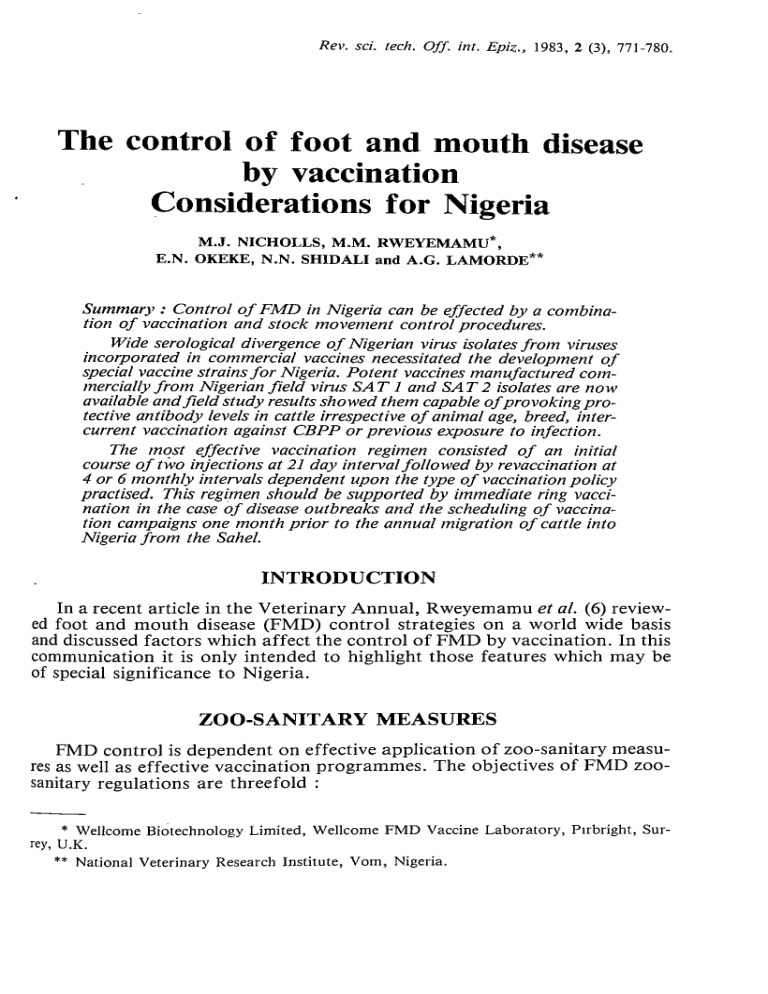
Rev. sci. tech. Off. int. Epiz., 1983, 2 (3), 771-780. The control of foot and mouth disease by vaccination Considerations for Nigeria M.J. NICHOLLS, M . M . R W E Y E M A M U * , E . N . OKEKE, N . N . S H I D A L I and A . G . L A M O R D E * * Summary : Control of FMD in Nigeria can be effected by a combina­ tion of vaccination and stock movement control procedures. Wide serological divergence of Nigerian virus isolates from viruses incorporated in commercial vaccines necessitated the development of special vaccine strains for Nigeria. Potent vaccines manufactured com­ mercially from Nigerian field virus SAT 1 and SAT 2 isolates are now available and field study results showed them capable of provoking pro­ tective antibody levels in cattle irrespective of animal age, breed, inter­ current vaccination against CBPP or previous exposure to infection. The most effective vaccination regimen consisted of an initial course of two injections at 21 day interval followed by revaccination at 4 or 6 monthly intervals dependent upon the type of vaccination policy practised. This regimen should be supported by immediate ring vacci­ nation in the case of disease outbreaks and the scheduling of vaccina­ tion campaigns one month prior to the annual migration of cattle into Nigeria from the Sahel. INTRODUCTION In a recent article in the Veterinary Annual, Rweyemamu et al. (6) review­ ed foot and m o u t h disease (FMD) control strategies on a world wide basis and discussed factors which affect the control of F M D by vaccination. In this communication it is only intended to highlight those features which may be of special significance t o Nigeria. ZOO-SANITARY MEASURES FMD control is dependent on effective application of zoo-sanitary measu­ res as well as effective vaccination programmes. The objectives of F M D zoosanitary regulations are threefold : * Wellcome Biotechnology Limited, Wellcome F M D Vaccine Laboratory, Pirbright, Sur­ rey, U.K. ** National Veterinary Research Institute, V o m , Nigeria. — 772 — 1. Prevention of virus entry into the country or district. 2. Limitation of virus spread if disease should be encountered. 3. Elimination of the virus from the environment as speedily as practica­ ble. In practice, in F M D endemic zones like West Africa, successful applica­ tion of zoo-sanitary measures requires that effective systems should be evol­ ved and practised strictly in relation to the control of all animal movements from outside and within the F M D control zone. Controlled systematic prophylactic vaccination should also be practised. In the face of an outbreak, immediate quarantine of the infected foci should be enforced coupled with ring vaccination covering a wide perimeter around the infected premise(s), which should never be less than 5 miles. It is essential to be able to confirm every outbreak by laboratory serotyping of the virus. In Africa an example of strict application of zoo-sanitary measures in support of a vaccination programme is best illustrated by the F M D control programme in Botswana (3). The country is divided into 4 zones by fencing. Movement of cattle from one zone to the next is strictly controlled including physical inspection of each animal. In Kenya it was possible to create a zone in central Kenya which was for long periods free of F M D as a result of synchronised vaccination and strict control of animal movement in and out of the zone (1). However, with the recent expansion of the control zone, an increase in multiple and relatively uncontrollable trade stock movement and uneven vaccination cover have all contributed to a reduction in the apparent effectiveness of F M D control as assessed by outbreak incidences. The burden of F M D control in Kenya seems to have shifted towards exclusive dependence on vaccination. Nevertheless all recent economic analyses have found a favourable cost : benefit ratio in support of F M D control and consequently the area covered by the F M D vaccination programme has progressively been expanded every 2-3 years (2). THE VACCINE FACTOR It is evident that an important component in any F M D programme is the availability of potent vaccines. Current commercial vaccines are tested in the country of manufacture and must be shown to meet the standards defined by the European Pharmacopoeia or the British Veterinary Codex before their release for sale. Nevertheless, performance of a vaccine under field condi­ tions is not merely a function of the quality of the vaccine at the time of its release by the manufacturer. It depends on several factors such as : 1. its potency at the time of vaccination in the field; 2. the antigenic relationship between the vaccine virus and field viruses; 3. the vaccination regimen and the interval between revaccination and disease incidence; — 773 — 4. the immune responsiveness of animals; 5. the weight of virus challenge. Several reports from Nigeria have indicated that imported commercial vaccines have performed suboptimally under Nigerian conditions. Mowat et al. (5) showed that BHK produced experimental vaccines containing local Nigerian virus strains were able to provoke a satisfactory immune response in either British cattle vaccinated at Pirbright or Nigerian cattle vaccinated at Vom. This demonstrated clearly that the immune responsiveness of Nigerian cattle was satisfactory. Previous studies at the Wellcome Laboratory, Pirbright had shown that Nigerian SAT 1 and SAT 2 virus isolates were serologically different from virus strains currently used for producing vaccines for Eastern and Southern Africa (Tables I and II). Such vaccines, therefore, would be expected to pro­ voke a suboptimal response against Nigerian field virus isolates. TABLE I Serological relationship between Nigeria 9/72 field virus and SAT 1 vaccine viruses. r values Vaccine Antiserum SAT 1 Sar. 4/74 SAT 1 Nigeria 9/72 0.19** 0.07** ** r values significantly different from 1.00 at p = 0.01. r value = Ratio of serum litre against heterologous: homologous virus. Serum titres were determined in two-dimensional microneutralization tests. This test had a variance of 0.106. Significance of individual r values were based on this variance and the number of replicates for each comparison (3 to 6). With the recent declared interest of the Federal Government to initiate a foot and mouth disease control p r o g r a m m e it became essential to establish first and foremost whether it is possible to produce potent vaccines from Nigerian virus strains or those virus strains previously shown to be appro­ priate for Nigeria. The second consideration was whether such commercial vaccines would produce a satisfactory immune response in Nigerian cattle and the third was whether a suitable regime could be evolved. SAT 1 Nig 4/81 and SAT 2 Nig 6/81 virus strains were successfully adapted to rapid growth in BHK suspension cells at the industrial scale. The potency characte­ ristics of the commercial bivalent SAT 1/SAT 2 vaccine so produced are summarized in Table III. — 774 — TABLE II Serological relationships between Nigerian SAT 2 6/81 field virus isolate and FMD vaccine viruses. r values Serum SAT 2 6/81 virus SAT 2 Ken 3/57 Tan 5/68 K 183/74 R 1215 Moz 1/70 Bot 3/77 Zim 8/80 0.07** 0.17** 0.02** 0.01** 0.13** 0.09** 0.06** ** r values 1.00 at p = 0.01 TABLE III Potency characteristics of vaccine batch 414 Virus strain 140S antigen content/dose (ugms) P D value (cattle test) SAT 2 Nig 6/81 SAT 1 Nig 4/81 3.54 5.70 25.0 25.0 VACCINATION 5 0 REGIMEN A field study was carried out with a commercially produced vaccine using cattle kept at the National Veterinary Research Institute, Vom. The study was designed to include the effect on vaccine response of age, breed, intercur­ rent vaccination against C B P P and to determine a suitable vaccination regi­ men. Groups of Holstein-Friesian cattle aged from 6 to 12 months, 1 to 2 years and over 3 years were vaccinated with bivalent SAT 1 / S A T 2 vaccine admi­ nistered either as an initial single vaccination at day 0 only or as an initial course of two injections at 21 days interval with some animals receiving boos­ ter vaccinations at 120 days post vaccination (dpv). One group of 1-2 years old Holstein-Friesian cattle and a group of Fulani cattle aged over 2 years were vaccinated with vaccine against C B P P at day 0 in addition to receiving FMD vaccine at the same time and 21 days later (Table IV). All the cattle were bled at intervals up to day 180 and sera were stored at - 2 0 ° C until transported to the Wellcome Laboratories, Pirbright where they were assayed for neutrali- — 775 — TABLE I V Experimental design of the vaccination schedule. Vaccination No. of animals Group Age Day 0 1 2 3 10 10 10 6-12 months 6-12 months 6-12 months FMD FMD FMD 4 5 6 7 10 10 10 10 1-2 1-2 1-2 1-2 FMD FMD FMD CBPP/ FMD 8 9 10 10 10 10 3 years 3 years 3 years FMD FMD FMD 11 10 2 years CBPP/ FMD years years years years Day 21 Day 120 FMD FMD FMD FMD FMD FMD FMD FMD FMD FMD FMD zing antibodies against the two vaccine viruses using a microneutralization cytopathic effect test employing IBRS-2 cells (4). The results of serological assay show that all the Nigerian cattle respon­ ded well to both vaccine viruses (Table V). The young cattle responded parti­ cularly well, with Fulani cattle responding as well as the Friesian breed (Figu­ res 1 and 2) and simultaneous vaccination against C B P P provoked no adverse effect on F M D vaccine response (Table V). The cattle in this study had previously been exposed to infection with SAT 1 virus, which left cattle over one year of age with residual titres of over 2 log S N at day 0. This age group gave a typical anamnestic response to vac­ cination with the SAT 1 component with titres reaching over 3 l o g S N by 21dpv (Figure 1) and maintaining in the region of 2.5 log10 180 days later. Not all calves aged between 6 and 12 months had these residual antibody titres at the commencement of the study however, and these showed a typical primary response to vaccination with titres over 2.5 l o g at 21dpv which were maintained at over 1.5 l o g and 1.25 l o g at 120 and 180dpv, respectively. An initial course of two injections improved the duration of response to over 2.0 l o g at both 120 and 180dpv (Figure 1). The primary response to vaccina­ tion with the SAT 2 component was between 1.5 and 2.4 l o g at 21dpv, depending on the animal groups, and titres were maintained in the region of 1 to 1.5 l o g u p to 180dpv. An initial course of two injections improved this response, particularly in young cattle where titres peaked over 2.5 l o g and 10 50 10 5 0 ]0 10 10 I0 I0 10 ]0 — 776 — TABLE V Group Mean Log 10 Age Group SN 50 Titres. SAT 2 Nigeria 6/81 Titres Vaccination schedule Days 0 21 35 120 150 180 1 2 3 6-12 months 6-12 months 6-12 months 0 0 + 21 0 + 21 + 120 0.73 0.72 0.84 1.93 2.37 1.58 2.09 2.49 2.63 1.36 1.32 1.77 1.38 1.28 2.93 1.08 1.13 1.88 4 5 6 7 1-2 1-2 1-2 1-2 0 0 + 21 0 + 21 + 120 0 + 21* 0.67 0.65 -1.09 0.70 2.17 1.81 1.94 1.89 1.95 2.77 2.82 2.75 0.95 1.51 1.48 1.34 1.28 1.35 2.07 1.16 1.19 1.38 2.18 1.38 years years years years 8 9 10 3 years 3 years 3 years 0 0 + 21 0 + 21 + 120 0.99 0.71 0.92 1.69 1.64 1.58 1.57 1.52 1.97 1.18 1.03 1.09 1.36 1.21 1.61 1.31 1.23 1.36 11 2 years + Fulani 0 + 21* 0.90 1.87 1.83 1.47 1.49 1.46 Group Age SAT 2 Nigeria 6/81 Titres Vaccination schedule Days 0 21 35 120 150 180 1 2 3 6-12 months 6-12 months 6-12 months 0 0+21 0 + 21 + 120 1.27 0.72 1.71 2.65 >2,47 2.36 2.66 >2.63 3.41 1.60 >2.00 2.05 NS 1.83 2.93 1.34 2.24 2.33 4 5 6 7 1-2 1-2 1-2 1-2 0 0 + 21 0 + 21 + 120 0 + 21* 2.41 >2.68 2.73 2.42 >3.12 2.90 3.20 2.61 3.31 3.38 3.27 3.56 2.57 2.82 2.42 2.80 2.66 2.43 3.00 2.51 2.36 2.96 3.18 2.38 years years years years 8 9 10 3 years 3 years 3 years 0 0 + 21 0 + 21 + 120 2.31 2.18 2.39 3.68 3.80 3.48 3.28 3.53 3.18 2.89 2.67 2.69 2.71 2.48 2.75 2.53 2.56 2.81 11 2 years + Fulani 0 + 21* 2.31 3.33 3.18 2.70 2.58 2.73 * C B P P vaccine given to Group at Day 0. N N S = N o serum — 777 DAYS POST t vaccination VACCINATION points FIG. 1 Response of Nigerian cattle to FMD vaccination : SAT 1 Nigeria 4/81. — 778 3 r 2 j 0 60 120 DAYS POST 6-12 o 180 VACCINATION months old o 1-2 years old \ i vaccination FIG. >3 years old >2 y e a r s o l d Fulani points 2 Response of Nigerian cattle to FMD vaccination SAT 2 Nigeria 6/81. — 779 — were maintained between 1.25-1.5 l o g at 180dpv (Figure 2). Revaccination at 120 days improved responses in all cases (Figures 1 and 2). 10 DISCUSSION A N D CONCLUSIONS It has been demonstrated that potent vaccines can be produced on the commercial scale, employing SAT 1 and SAT 2 virus strains isolated from the field in Nigeria. The vaccines maintained their potency during transport from their point of manufacture in the U.K. until they were administered to cattle in Nigeria. Nigeria cattle responded satisfactorily to vaccination, irrespective of age, breed, or simultaneous vaccination with C B P P vaccine and, in the case of SAT 1, prior exposure to F M D . The response provoked in cattle vaccinated for the first time was shown to be improved by administering the vaccine as an initial course of two injections at 21 day intervals as advised in the manufacturer's 'Directions for Use'. The antibody profile provoked in the field study indicated that protection of Nigerian cattle could best be achieved by adopting the following regimens, the choice of which is dependent upon the vaccination policies applied by the Federal authorities. a) Primary vaccination should optimally be applied as a course of two injections administered at 21 day interval. b) Revaccination at 6 monthly intervals will adequately protect the bovine population, provided that the control policy is for blanket vaccination of all cattle on an extended zonal or national basis, together with adequate zoosanitary measures including movement controls. c) If F M D control policy is to rely on the routine vaccination of selected isolated herds or farms then it would be prudent to revaccinate the stock at 4 monthly intervals in order to maintain a high level of immunity. Regardless of the vaccination regimen adopted it will be necessary to revaccinate all stock at risk immediately should an outbreak of disease occur. Furthermore, vaccination programmes should be scheduled so that both primovaccinates and previously vaccinated stock receive vaccinations within 1 month of the time of greatest challenge expectancy. This would mean, in particular, revaccination of all stock prior to the expected annual animal migrations into Nigeria from the Sahel. * * * LE CONTRÔLE DE LA FIÈVRE APHTEUSE PAR LA VACCINATION : CONSIDÉRATIONS PARTICULIÈRES AU NIGÉRIA. — M.J. Nicholls et M.M. Rweyemamu. Résumé : Le contrôle de la fièvre aphteuse peut être effectué en associant la vaccination aux mesures de contrôle des mouvements de bétail. — 780 — Les souches nigérianes de virus aphteux sont très différentes, sur le plan sérologique, des virus incorporés dans les vaccins commerciaux, ce qui a nécessité la mise au point de souches vaccinales spéciales pour le Nigéria. Des vaccins efficaces fabriqués au stade commercial à partir des souches virales sauvages nigérianes SAT 1 et SAT 2 sont désormais disponibles et les résultats d'essais sur le terrain ont montré qu'ils étaient capables de susciter des taux d'anticorps protecteurs chez les bovins, quelque soit leur âge, leur race, leur vaccination simultanée contre la péripneumonie contagieuse ou leur contamination antérieure. Le protocole de vaccination le plus efficace a consisté en une administration initiale de deux injections à 21 jours d'intervalle suivies d'un rappel tous les 4 ou 6 mois selon le protocole de vaccination pratiqué localement. Ce protocole devra être étayé par une vaccination immédiate en anneau et la programmation de campagnes de vaccination un mois avant l'immigration annuelle des bovins du Sahel dans le Nigéria. * ** REFERENCES 1. CHEMA S. (1975). — Vaccination as a method of foot and mouth disease control; an appraisal of the success achieved in Kenya 1968-1983. 14th Conf. OIE Comm. Paris, Rep. No. 200. 2. CREES H.J.S. (1982). — A brief administrative history of foot and mouth disease and its control in Kenya. Rural Development studies. No. 14, Swedish University of Agricultural Sciences, Uppsala, 1982. 3. FALCONER J. (1972). — The epizootiology and control of foot and mouth disease in Botswana. Vet. Rec., 91, 354-359. 4. FRANCIS M.J., OULDRIDGE E.J. and BLACK L. (1983). — Antibody response in cattle pharyngeal fluid following foot and mouth disease vaccination and/or exposure to live virus. Res. Vet. Sci. (in press). 5. MOWAT G.N., PRINCE M.J., OWEN H. and TAYLOR W.P. (1975). — Results of a small-scale field trial in Nigerian cattle of FMD vaccines produced from local virus strains. Bull. Off. int. Epiz., 83, 283-296. 6. RWEYEMAMU M.M., PAY T.W.F. and SIMMS M.J. (1982). — The control of foot and mouth disease by vaccination. The Veterinary Annual. 22nd Edition. 63-80. Editors Grunsell and Hill, published by John Wright and Sons, Bristol, England.


